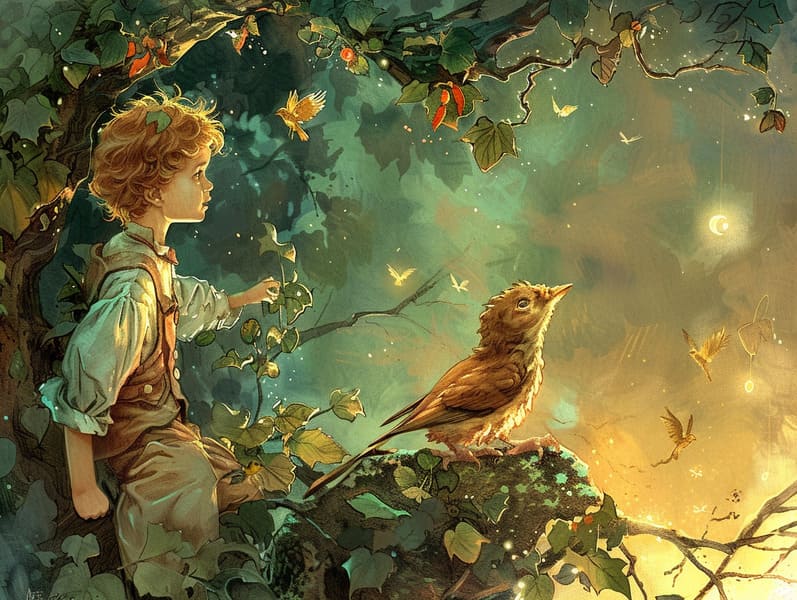
Historical fairy tales have historical significance. These tales have been relayed from one generation to the next well before they were ever inscribed. They emerged from a variety of civilizations, including Eastern traditions. They were initially told among grown-ups, often carrying themes and messages related to the societal norms and beliefs of the time.
The famous Grimm duo, Jacob and Wilhelm (the Grimm brothers), were among the first to gather and publish many of these beloved stories. Their anthology, "Grimm's Folk Tales," included narratives like "Cinder Maid," "Little Brother and Little Sister," and "Snow White," which have since become essentials in the world of children's fairy tales. Similarly, Andersen's fantastical fairy tales, such as "The Little Mermaid," and "The Ugly Duckling," have captivated hearts worldwide, solidifying their place in the pantheon of treasured fairy tales.
Though they are centuries old, classic fairy tales remain as applicable as ever, especially as kids' bedtime tales. These charming stories are now available in different formats, including vibrantly illustrated books, whimsical animations, and online storybooks.
Their continued relevance can be attributed to several whimsical characteristics:
Key Lessons: Ancient fairy tales often convey important moral lessons. Narratives like "The Tale of the Boy Who Cried Wolf" teach the importance of sincerity, while "The Hare and the Tortoise" exemplify the qualities of persistence and unpretentiousness. These stories offer young readers clear distinctions between truth and falsehood, guiding their moral compass in a soft yet meaningful way.
Kindness and Comprehension: Old fairy tales frequently present personalities facing struggles and tests, fostering young listeners to understand with their struggles and boost their triumphs. For instance, "Beauty's Beast" reveals the importance of seeing beyond the surface to know the true character of a character, cultivating warmth and knowledge.
Cultural Understanding: Many traditional fairy tales are saturated in the cultural contexts from which they were born. Immersing in these fairy tales can provide delightful insights into different societies, cultivating a sense of world respect and acknowledgment.
Fantasy and Innovation: The fantasy-filled elements in fairy tales—spells and potions—spark children’s fantastical thinking. These narratives guide readers to imaginary realms, triggering imaginative dreams and a sense of enchantment that stays a lifetime.
Ancient fairy tales are not only charming but also illuminating. They serve as entrancing tools in promoting various cognitive and emotional skills in young ones. When ancient fairy tales are spoken out loud, they promote verbal development by introducing new linguistic elements and elaborate sentence structures. This practice also boosts hearing abilities and attentiveness, as kids hang on every word, looking forward to see what happens next.
Furthermore, discussing the themes and characters of timeless fairy tales can develop reasoning skills and problem-solving abilities. Young readers learn to pinpoint patterns, foresee events, and figure out cause and effect. These contemplations also promote little ones reveal their thoughts and feelings, promoting their emotional intelligence.
In today’s technological age, the availability of digital fairy tales has made these narratives more accessible than ever. Websites and software make available ample collections of timeless fairy tales that can be experienced or heard anytime, anywhere. Fairy tales read aloud are particularly prevalent, providing an captivating way for the young to appreciate these fascinating tales. Voice books and read-out-loud stories bring characters and settings to life, often supported by bewitching music and instrumentals that augment the storytelling journey.
The unfading fascination of traditional fairy tales lies in their ability to change to modern days while sustaining their main lessons. Contemporary reinterpretations of these tales often show more varied protagonists and modern settings, making them relatable to today’s audience. However, the key lessons of daring, humanity, and honesty remain unchanged, continuing to connect with kids of all ages.
Ancient fairy tales also offer a sense of warmth and comprehensibility. They allow a coherent narrative with a obvious beginning, middle, and end, often closing with the wrap-up of conflicts and the triumph of rightness over wrongness. This dependability can be encouraging for young ones, showcasing a sense of steadfastness in an unstable world.
Traditional fairy tales continue to bewitch and inform new generations, maintaining their beauty and impact in modern society. As children's night stories, they introduce a perfect blend of magic and knowledge, nourishing moral values, empathy, and creativity. The availability of digital storybooks and the commonness of fairy tales read aloud certify that these traditional fairy tales remain acquirable to new generations.
By preserving and sharing these stories, we continue to admire the rich tapestry of cultural legacy and cultural heritage. Whether you are experiencing a colorful picture book, enjoying a web-based collection, these guys or listening on an sound book, the enchantment of Grimm's fairy tales is always within reach. These stories illustrate of the perpetual effect of fairy tales and its ability to bring us together across centuries and lands.
Even if you are enjoying a colorful picture book, accessing a online collection, or listening through an voice book, the beauty of Grimm's fairy tales is always within reach.
These fairy tales convey of the unwavering presence of fairy tales and its ability to link us across eras and regions, weaving a spell that charms and informs alike.